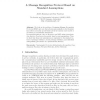ACNS
2010
Springer
14 years 3 months ago
2010
Springer
Secure sketches are useful in extending cryptographic schemes to biometric data since they allow recovery of fuzzy secrets under inevitable noise. In practice, secrets derived from...
ACNS
2010
Springer
14 years 4 months ago
2010
Springer
We propose COP, a client-side system for protecting children’s online privacy and empowering parental control over children’s information disclosure with little manual effort. ...
ACNS
2010
Springer
14 years 5 months ago
2010
Springer
Abstract. This work presents a new method to compute the GHASH function involved in the Galois/Counter Mode of operation for block ciphers. If X = X1 . . . Xn is a bit string made ...
ACNS
2010
Springer
14 years 5 months ago
2010
Springer
In this work, we develop a family of protocols for deniable Internet Key-Exchange (IKE) with the following properties: • Highly practical efficiency, and conceptual simplicity a...
ACNS
2010
Springer
14 years 5 months ago
2010
Springer
Most side-channel attacks that have been published in the open literature assume known- or chosen-message adversarial scenarios. In this paper, we analyze the increase of the attac...
ACNS
2010
Springer
14 years 5 months ago
2010
Springer
To this day, realizations in the standard-model of (lossy) trapdoor functions from discrete-log-type assumptions require large public key sizes, e.g., about Θ(λ2 ) group elements...
ACNS
2010
Springer
14 years 5 months ago
2010
Springer
Abstract. We introduce WORM-ORAM, a first mechanism that combines Oblivious RAM (ORAM) access privacy and data confidentiality with Write Once Read Many (WORM) regulatory data re...
ACNS
2010
Springer
14 years 5 months ago
2010
Springer
ACNS
2010
Springer
14 years 5 months ago
2010
Springer
We look at the problem of designing Message Recognition Protocols (MRP) and note that all proposals available in the literature have relied on security proofs which hold in the ran...
ACNS
2010
Springer
14 years 5 months ago
2010
Springer
Abstract. In 2008, Groth and Sahai proposed a general methodology for constructing non-interactive zeroknowledge (and witness-indistinguishable) proofs in bilinear groups. While av...






